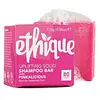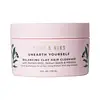What's inside
What's inside
 Key Ingredients
Key Ingredients

 Benefits
Benefits

 Concerns
Concerns

 Ingredients Side-by-side
Ingredients Side-by-side

Sodium Coco-Sulfate
CleansingSodium Cocoyl Isethionate
CleansingStearic Acid
CleansingDecyl Glucoside
CleansingWater
Skin ConditioningTheobroma Cacao Seed Butter
EmollientBrassica Alcohol
EmollientGlycerin
HumectantLactic Acid
BufferingCocos Nucifera Oil
MaskingCaprylic/Capric Triglyceride
MaskingCocos Nucifera Fruit
AbrasiveCitrus Paradisi Peel Oil
MaskingSodium Isethionate
CleansingLimonene
PerfumingBehentrimonium Methosulfate
Parfum
MaskingMica
Cosmetic ColorantCI 77891
Cosmetic ColorantCI 77491
Cosmetic ColorantSodium Coco-Sulfate, Sodium Cocoyl Isethionate, Stearic Acid, Decyl Glucoside, Water, Theobroma Cacao Seed Butter, Brassica Alcohol, Glycerin, Lactic Acid, Cocos Nucifera Oil, Caprylic/Capric Triglyceride, Cocos Nucifera Fruit, Citrus Paradisi Peel Oil, Sodium Isethionate, Limonene, Behentrimonium Methosulfate, Parfum, Mica, CI 77891, CI 77491
Glycerin
HumectantSodium Cocoyl Isethionate
CleansingKaolin
AbrasiveCoconut Acid
CleansingVaccinium Corymbosum Seed
AbrasiveCetearyl Alcohol
EmollientPolylactic Acid
AbrasiveSodium Isethionate
CleansingCocos Nucifera Oil
MaskingBentonite
AbsorbentBehentrimonium Methosulfate
Tapioca Starch
Moringa Oleifera Seed Oil
EmollientSimmondsia Chinensis Seed Oil
EmollientArnica Montana Flower Extract
MaskingEclipta Prostrata Leaf Extract
Skin ConditioningHibiscus Esculentus Fruit Extract
Skin ConditioningPhyllanthus Emblica Fruit Extract
HumectantParfum
MaskingPhenoxyethanol
PreservativeCaprylyl Glycol
EmollientGlycerin, Sodium Cocoyl Isethionate, Kaolin, Coconut Acid, Vaccinium Corymbosum Seed, Cetearyl Alcohol, Polylactic Acid, Sodium Isethionate, Cocos Nucifera Oil, Bentonite, Behentrimonium Methosulfate, Tapioca Starch, Moringa Oleifera Seed Oil, Simmondsia Chinensis Seed Oil, Arnica Montana Flower Extract, Eclipta Prostrata Leaf Extract, Hibiscus Esculentus Fruit Extract, Phyllanthus Emblica Fruit Extract, Parfum, Phenoxyethanol, Caprylyl Glycol
Ingredients Explained
These ingredients are found in both products.
Ingredients higher up in an ingredient list are typically present in a larger amount.
Behentrimonium Methosulfate is an ammonium salt. It is mainly used to prevent static in haircare products as a surfactant.
Surfactants have differing ends: one side is hydrophilic while the other end is hydrophobic.
Surfactants also help your cleansers remove pollutants more easily from the skin.
Learn more about Behentrimonium MethosulfateCocos Nucifera Oil is obtained from the kernels of the coconut fruit. In other words, this is coconut oil.
Coconut Oil is rich in fatty acids with lauric acid making up the majority of these. It also contains linoleic acid. Due to this high fatty acid content, coconut oil helps trap moisture and soften skin.
Despite being antibacterial, coconut oil may not be great for acne-prone skin. It is comedogenic and may clog pores. This ingredient may not be safe for malassezia or fungal acne.
Note: Coconut Oil should not replace your sunscreen for UV protection. Studies show it only blocks about 20% of UV.
This oil is non-volatile and has a light scent.
The term 'fragrance' is not regulated in many countries. In many cases, it is up to the brand to define this term. For instance, many brands choose to label themselves as "fragrance-free" because they are not using synthetic fragrances. However, their products may still contain ingredients such as essential oils that are considered a fragrance.
Learn more about Cocos Nucifera OilGlycerin is already naturally found in your skin. It helps moisturize and protect your skin.
A study from 2016 found glycerin to be more effective as a humectant than AHAs and hyaluronic acid.
As a humectant, it helps the skin stay hydrated by pulling moisture to your skin. The low molecular weight of glycerin allows it to pull moisture into the deeper layers of your skin.
Hydrated skin improves your skin barrier; Your skin barrier helps protect against irritants and bacteria.
Glycerin has also been found to have antimicrobial and antiviral properties. Due to these properties, glycerin is often used in wound and burn treatments.
In cosmetics, glycerin is usually derived from plants such as soybean or palm. However, it can also be sourced from animals, such as tallow or animal fat.
This ingredient is organic, colorless, odorless, and non-toxic.
Glycerin is the name for this ingredient in American English. British English uses Glycerol/Glycerine.
Learn more about GlycerinParfum is a catch-all term for an ingredient or more that is used to give a scent to products.
Also called "fragrance", this ingredient can be a blend of hundreds of chemicals or plant oils. This means every product with "fragrance" or "parfum" in the ingredients list is a different mixture.
For instance, Habanolide is a proprietary trade name for a specific aroma chemical. When used as a fragrance ingredient in cosmetics, most aroma chemicals fall under the broad labeling category of “FRAGRANCE” or “PARFUM” according to EU and US regulations.
The term 'parfum' or 'fragrance' is not regulated in many countries. In many cases, it is up to the brand to define this term.
For instance, many brands choose to label themselves as "fragrance-free" because they are not using synthetic fragrances. However, their products may still contain ingredients such as essential oils that are considered a fragrance by INCI standards.
One example is Calendula flower extract. Calendula is an essential oil that still imparts a scent or 'fragrance'.
Depending on the blend, the ingredients in the mixture can cause allergies and sensitivities on the skin. Some ingredients that are known EU allergens include linalool and citronellol.
Parfum can also be used to mask or cover an unpleasant scent.
The bottom line is: not all fragrances/parfum/ingredients are created equally. If you are worried about fragrances, we recommend taking a closer look at an ingredient. And of course, we always recommend speaking with a professional.
Learn more about ParfumSodium cocoyl isethionate is a natural ingredient from coconut oil. It is an ultra gentle cleanser that gives a nice foam without drying the skin or impacting the skin barrier.
The amount of foam created depends on the amount of sodium cocoyl isethionate used in the product.
This ingredient also helps improve the spreadability of a product.
Learn more about Sodium Cocoyl IsethionateWe don't have a description for Sodium Isethionate yet.